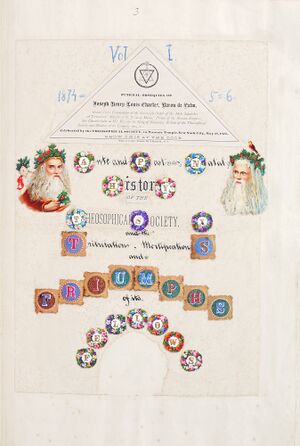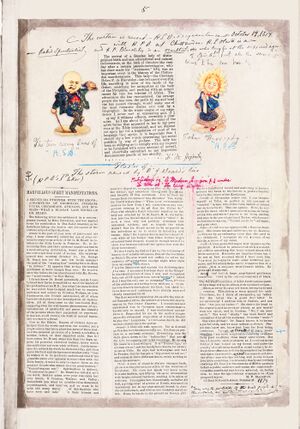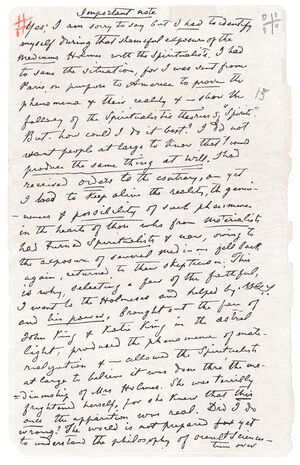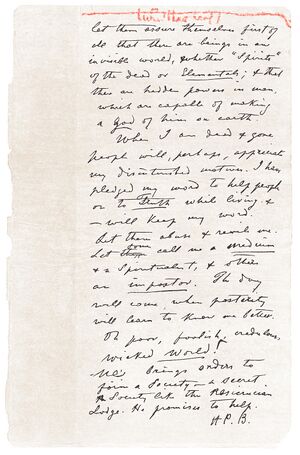Boldyrev O. - The Personal Archive of HPB
The Personal Archive (Scrapbooks) of H.P. Blavatsky in the Adyar Archives of the Theosophical Society
The original report of the visit to the Theosophical Society (Adyar) Headquarters in October—November of 2016 of the editorial team working towards the publication of the Russian Collected Works of H.P. Blavatsky (further – Russian Collected Works) was written by Pavel Malakhov soon after our return[1]. The goal of this report is to present the results of our work with the first three Albums (the total number is 24) in HPB’s personal archive.
Endeavoring on the journey to the Headquarters, we did not know whether we would be able to find any new materials for the Collected Works and till the end were not sure if we would be able to work at the Society’s Archive at all. This nuance is explained by the fact that earlier our other Russian colleagues, devoted to the study of HPB’s life and work, had only been admitted to the Society’s library. But, as the saying goes, everything changes, and due to the stance of the new President of the Society (who had been elected relatively recently, in the fall of 2014) and his presence in Adyar at the time, we were among the first of those who received the opportunity to closely collaborate with all the associates in charge of the Archive and gain access to the content it holds.
We are, of course, lucky that President Tim Boyd has contemporary views regarding the creation of digital copies of the archival materials and publication of them online. Since March of 2016 there has been professional work conducted at the Adyar Archives on the digitization of printed materials, and due to that, the content of several of the earliest albums, necessary for the second and third volumes of RCW HPB, was available to us as digital copies. The President has also been planning to publish the Adyar archives on the internet.
The story of creation by HPB of her personal archive, comprising newspaper and magazine articles, letters, poems, advertisements and artwork, started in the town of Chittenden, Vermont, USA, in the fall of 1874, coinciding with her meeting Henry Steel Olcott (further – HSO). The first meeting of the Founders was due to their interest in the spiritualistic phenomena that had been occurring for quite a while at the farm of the Eddy brothers, and which received public attention in 1874 following publications in the American press. Beginning with the end of September that year, and until the beginning of December, Col. Olcott spent the total of 10 weeks at the Eddy estate in the role, as it was called then, a commissioner – a correspondent of the New York paper Daily Graphic that assigned him to visit the mediums Horatio and William Eddy, and to which he sent regular reports about everything encountered during the séances. The Daily Graphic regularly published his letters – which amount to about 20 – supplementing them with the illustrations of the observed phenomena, produced by two graphic artists specially delegated to the Chittenden farm to aid HSO. HPB, who learnt what was happening at the Eddy farm from the newspaper publications, arrived at Chittenden on October 14 and spent there nearly two weeks. With her appearance, the “spirits” materialized by the Eddy brothers, to the amazement of the attendants, began to look like Persians, Kurds, Georgians, Circassians, Africans – which had not been the case before, for the figures primarily manifested at the prior seances were those of Native Americans and the deceased relatives of the white American attendees. Finally, one of the séances saw manifested even HPB’s “uncle” Gustav von Hahn. AS H.P.B. wrote in her first article on Eddy's manifestation,
"A large grey-haired gentleman comes out attired in the conventional suit of black. The Russian decoration of Saint Ann hangs suspended by a large red moiré ribbon with two black stripes—a ribbon, as every Russian will know, belonging to said decoration. This ribbon is worn around his neck. I feel faint, for I think of recognizing my father. But the latter was a great deal taller. In my excitement I address him in English, and ask him: “Are you my father?” He shakes his head in the negative, and answers as plainly as any mortal man can speak, and in Russian, “No; I am your uncle.” The word “diadia” has been heard and remembered by all the audience. It means “uncle”."
After this “George Dix” and “Mayflower”, main materialized “spirits” of Eddy’s manifestations, gifted to H.P.B. really material thing—medal for bravery that had belonged to HPB’s father, Captain Peter A. von Hahn, and was received by him in the Russo-Turkish war of 1827—1828. To the great bewilderment of others present and H.P.B. herself, the “spirits” reported that the insignia had been taken from the grave of H.P.B.’s father, buried in Stavropol in 1873 with all of his war medals, and these “spirits” delivered the said iron insignia to H.P.B. as a family relic and a memorable material proof of the reality of the phenomena.
Col. Olcott, who treated the phenomena he observed with the greatest interest and responsibility, was deeply impressed by the events that had occurred at the Eddy farm in connection with H.P.B. and by her very dazzling personality. This became the grounds for the mutual interest and respect between the two persons who, one year later, laid the foundation for the Theosophical Society. The same events also mark the origin of H.P.B.’s personal archive, the first pages of which contain the articles on the remarkable phenomena produced by the Eddy brothers, which served as the point for the meeting of the Founders.
The materials for her archive were collected by H.P.B. from October, 1874, through 1888, picking out from newspapers and journals all publications authored by her, articles by H.S.O., as well as those by a wide range of writers on the subjects of spiritualism, Theosophy, philosophy, science, religion and history. She decorated the pages of her archive with artistic illustrations and poetic works by various authors, which she also clipped from the newspapers and magazines, and, most importantly, left her own handwritten comments and remarks.
The total article count on the 208 pages of the volume I of the Albums, comprising materials from 1874—1876, is 308 publications, of which 27 belonged to H.P.B. (signed by her name), 37 authored by Olcott, and 3 were co-authored by H.P.B. and H.S.O. The rest of the articles belong to various authors, including those written under a pseudonym, or published without a name. Overall, there are 83 figures on 59 pages, and 96 pages contain handwritten remarks by H.P.B.
The second volume is significantly smaller, counting 100 pages, and contains materials from 1876—1878. It appears to represent the concluding part of the first volume, separated from it during the last binding (of which there were three). There are 124 articles (not just those published) in the second volume, pertaining primarily to the story of publishing of Isis Unveiled: a number of excerpts, advertisements, notices, reviews, and letters received by H.P.B. after the work saw the light of day in 1877; therefore, most of the material in the volume may be regarded as authored by H.P.B., although only two of the articles are signed by her name. Handwritten remarks by H.P.B. appear on 16 pages. There is only one figure in the whole album. The album also contains 32 unsigned small notices from the New York’s Sun of 1872 – when H.P.B. still lived in Europe. This is the same paper that featured Olcott’s first article on the Eddy phenomena in the summer of 1874, following his short visit; however, this article has not been located in the albums.
The third album comprises materials from 1875—1878 on 278 pages with the total of 387 newspaper articles of the most diverse character (including 4 articles and several figures from the Russian press, not authored by H.P.B.) and over 100 figures. H.P.B.’s remarks occur on 53 pages.
The articles in the albums vary greatly in size: one page may contain up to 5—6 clippings, but there are articles taking several pages.
Not without some regret, we have to note that multiple (maybe several dozens) of the articles are likely to remain illegible due to the condition of the originals. Although we have taken the care to obtain digital archival copies of the main American and British publications that published articles by H.P.B., H.S. Olcott, and other Theosophists, and which can be of use for at least partial restoration of the texts of those articles that have been lost to time, nevertheless, a significant portion of the articles in the albums contain no indication of the author, place, or time of publishing.
The remarks in the previous paragraph should not be taken as a rebuke to anyone or anything, for every archive has its own circumstances, its own fate, to which we are grateful, without any exaggeration, for the preservation of the enormous fund of the Theosophical teaching and its history.

Below we provide the images and texts of the title and following pages with the articles from the first of H.P.B.’s albums. The text of the beautiful, tastefully designed by H.P.B. title page informs the reader that he is holding “Ante and post natal history of the Theosophical Society and the tribulations, mortifications and triumphs of its fellows.” Above the title, on the printed invitation to the cremation of Baron de Palm, a deceased member of the Theosophical Society, is placed the Society’s emblem.
On the next page of the first album is included, among other items, a fragment of the 16th letter-article by H.S. Olcott to the Daily Graphic (New York, Friday, November 27, 1874. P. 195), giving a vivid example of the effect that H.P.B.’s appearance had in Chittenden:
“The arrival of a Russian lady of distinguished birth and rare educational and natural endowments, on the 14th of October (the very day after a certain pseudo-investigator, who has since made his “statement,” left), was an important event in the history of the Chittenden manifestations. This lady—the Countess Helen P. de Blavatsky—has led a most eventful life, travelling in most of the lands of the Orient, searching for antiquities at the base of the Pyramids, and pushing with an armed escort far into the interior of Africa. The adventures she has encountered, the strange people she has seen, the perils by sea and land she has passed through, would make one of the most romantic stories ever told by a biographer. In the whole course of my experience I never met so interesting and. if I may say it without offence, eccentric a character. As I am about to describe some of the spirit forms that appeared to her in my, presence at the Eddy homestead, and am dependent, upon her for a translation of most of the languages they spoke, it is important that I should say a few words concerning her social position by way of preface. The lady has been so obliging as to comply with my request to be furnished with some account of herself, and cheerfully submitted to my inspection documentary proofs of her identity.”
The publication of this fragment is supplied with artwork, generally characteristic of the following pages, too. Thus, on the sidelines of many of the album pages (the articles themselves occurring in the albums without the sides), one can see handwritten notes by H.P.B. made in black ink (rarely, with blue or red pencil). They vary quite a lot in size – from one word, name, date, or underlined emphasis to a small note of a couple of dozen sentences – but as a rule they comprise several words or sentences containing a brief clarification of the history, meaning and purpose of the given publication, as well as H.P.B.’s attitude to the writer and what is written by him. H.P.B.’s explanations may pertain to any of the album materials – figures, poems, announcements, letters, her own articles, those by H.S.O. or any other author, including the anonymous ones.

Thus, the reader may see on the represented below and, due to difficult legibility of the original, quite drastically retouched by us copy of the page (page 5, Album vol. I, or P.A. H.P.B. I—5) the following:
- A newspaper clipping of the article by H.S. Olcott, a fragment of the text of which we supplied above, with an added handwritten remark by H.P.B. in the style well-known to her followers:
“..........................etc. etc. flapdoodle.”
- Above it, a handwritten note by H.P.B., saying that:
“The curtain is raised. — HSO‘s acquaintance on October 14, 1874, with H.P.B. at Chittenden. H.S. Olcott is a — rabid Spiritualist, and H.P.B. is an occultist, one who laughs at the supposed agency of “Spirits”!! (but all the same pretends to be one herself).”
- To the left and right of the clipping, colorful figures of a gentleman, dancing, with a cane and a cigar, whose left eye is winking at the reader, and a knitting lady whose headgear looks like the Sun. Below the caricature drawings, H.P.B.’s remark in pencil: “The two rising Suns of Future Theosophy…”, pertaining to both images, and further, under the dancing gentleman, “H.S.O.”, and under the figure of the lady, “H.P.B.”.
- “Flashes of the storm raised by Dr. Beard’s lies (H.P.B.’s 1st letter)” – H.P.B.’s autograph in pen and ink, referring to the article placed below comprising three newspaper columns.
- Below is pasted H.P.B.’s article from the New York’s paper Daily Graphic from October 30, 1874, the first one of her publications in the press known to-date – “Marvellous Spirit Manifestations.” The article relates H.P.B.’s own opinion regarding the materialization séances that had been happening in Chittenden, and in relation to an article by one Dr. Beard (G. Beard) who, having spent in Chittenden one day and a half, proceeded to unscrupulously slandering the séances, the brothers themselves, Col. Olcott, and the visitors present, “credulous fools.” In this newspaper article, the word “spirits” is placed inside quotation marks by H.P.B. several times and underlined with a blue pencil; with the same pencil is underlined the beginning of the sentence, “Though an Occultist of many years standing …” Below the article, in the lower right corner, is another autograph by H.P.B., severely damaged by time, as are, unfortunately, many other articles and H.P.B.’s handwritten remarks in the albums, and it is only partially legible:
“1874
They may be the portraits of the dead people then repro . . .
(they certainly are not Spirits or Souls) yet a real . . .
...nomenon produced by the Elementaries. H.P.B.”
It is worth noting here that this autograph is cited in the same exact manner by much esteemed Boris Zirkoff in the most well-known and complete collection of H.P.B. works in English “H. Р.Blavatsky. Collected Writings” in 14 vols. It is known that B. Zirkoff was preparing the first volume of H.P.B.’s articles in the first half of 1960 at the latest, and already then the condition of the originals did not allow him – nor, it follows, the Adyar archives staff, who were preparing for him the materials – to fully decipher the autograph.

- Next to some article titles one may notice a peculiar symbol in the shape of a cross with four dots in the corners. As we were informed at the archives, this symbol was used by the editors who worked on the albums to mark articles by H.P.B. We have not found any other symbols in the albums that would mark articles by other authors.
- Adjacent to the article title we can see a note added by one of the editors in pen and red ink: ‘Published in “A Modern Panarion”, p. 1 under the title of “The Eddy Manifestations.”’ This refers to the first collection of H.P.B.’s newspaper articles, known to us, published in London four years after her departure from the earthly plane. This was a compilation prepared by the Theosophical Publishing Society and printed by the H.P.B. Press under the title “A Modern Panarion: A Collection of Fugitive Fragments from the pen of H. P. Blavatsky. First Edition. Volume I,” London—New York—Madras, 1895. This edition included 86 articles written by H.P.B. during the period of 1874—1882. The first item in it is the very article “Marvellous Spirit Manifestations,” although under the new title “The Eddy Manifestations”; the publishers also changed the titles of other articles. We find it highly likely, although the publishers do not tell their readers about this, that the articles for the first collection of newspaper articles by H.P.B. were gleaned from the pages of her albums.
The latter conclusion may, in our opinion, be a good indication of the goal that H.P.B. pursued in creating the archive of publications – a personal archive as well as that of the Society. As the content of the albums shows, H.P.B.’s purpose was to collect important publications in one archive, which preserved for the descendants the history of the Theosophical Society and the Teaching of Theosophy disseminated by it.
Without such a depository of publications, created by the Founder of the Society, its followers would have spent significantly more of their strengths and powers on the same task and, probably, would not have accomplished it fully in the result. Articles by Theosophists had appeared in dozens of American, Indian, and European editions; to put them together even now, in the digital epoch, is not a simple task, and what is even perfectly clear, the adherents would not have the complete knowledge of the Society’s history and the opinions of its Founder on a diverse range of questions and facts, deposited in the form of handwritten autographs on the pages of the albums.
In the famous “Mahatma Letters to A.P. Sinnett” it has been said that the Mahatmas sent H.P.B. to the world with a mission “to gradually prepare the way for others”. And she has accomplished this task by having written and published the books on the Teaching of Theosophy, and also by having collected for the adherents an archive of the most important materials, part of which has been published in Russian, but most of which have not yet. In this respect it is our task to prepare and publish in the Russian Collected Works all the materials (which will be possible to decipher), collected by H.P.B. in this archive.
The author would like to use the occasion to invite to the participation in the project translators with the knowledge of Theosophy, history of science, philosophy, religion; also welcome are those who are willing to work on the recognition of the English texts using software followed by manual correction – for the quality of the originals does not allow to rely completely on software, however advanced.
We are grateful to all those helping the Russian Collected Works project and continue to work on the translation of the album articles from the first three volumes of H.P.B.’s personal archive, in order to make the following installments of the Collected Works as complete as possible.


In conclusion, we offer, perhaps, the most important, undated explanatory note relating to the background of the creation of the Theosophical Society found in the 1st album, on two separate sheets of paper between the pages 20 and 21, called “Important Note.” It has already been published multiple times but, typically, without the original, which is included below. Underlining emphases by H.P.B.
Yes. I am sorry to say that I had to identify myself during, that shameful exposure of the mediums Holmes with the Spiritualists. I had to save the situation, for I was sent from Paris on purpose to America to prove the phenomena and their reality and—show the fallacy of the Spiritualistic theories of “Spirits.” But how could I do it best? I did not want people at large to know that I could produce the same thing at will. I had received orders to the contrary, and yet, I had to keep alive the reality, the genuineness and possibility of such phenomena in the hearts of those who from Materialists had turned Spiritualists and now, owing to the exposure of several mediums fell back again, returned to their skepticism. This is why, selecting a few of the faithful, I went to the Holmeses and helped by M∴ and his power, brought out the face of John King and Katie King in the astral light, produced the phenomena of materialization and—allowed the Spiritualists at large to believe it was done thro’ the mediumship of Mrs. Holmes. She was terribly frightened herself, for she knew that this once the apparition was real. Did I do wrong? The world is not prepared yet to understand the philosophy of Occult Sciences–let them assure themselves first of all that there are beings in an invisible world, whether “Spirits” of the dead or Elementals; and that there are hidden powers in man, which are capable of making a God of him on earth.
When I am dead and gone people will, perhaps, appreciate my disinterested motives. I have pledged my word to help people on to Truth while living and—will keep my word. Let them abuse and revile me. Let some call me a medium and a Spiritualist, and others an impostor. The day will come when posterity will learn to know me better.
Oh poor, foolish, credulous, wicked world!
M∴ brings orders to form a Society — a secret Society like the Rosicrucian Lodge. He promises to help.
Footnotes
- ↑ Malakhov P., Quick review of HPB’s scrapbooks
See also
- Quick review of HPB’s scrapbooks by Pavel Malakhov
